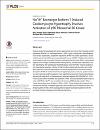Na+/H+ exchanger isoform 1-induced osteopontin expression facilitates cardiomyocyte hypertrophy

View/
Date
2015-04Author
Mohamed, Iman A.Gadeau, Alain-Pierre
Fliegel, Larry
Lopaschuk, Gary
Mlih, Mohamed
Abdulrahman, Nabeel
Fillmore, Natasha
Mraiche, Fatima
...show more authors ...show less authors
Metadata
Show full item recordAbstract
Enhanced expression and activity of the Na+/H+ exchanger isoform 1 (NHE1) has been implicated in cardiomyocyte hypertrophy in various experimental models. The upregulation of NHE1 was correlated with an increase in osteopontin (OPN) expression in models of cardiac hypertrophy (CH), and the mechanism for this remains to be delineated. To determine whether the expression of active NHE1-induces OPN and contributes to the hypertrophic response in vitro, cardiomyocytes were infected with the active form of the NHE1 adenovirus or transfected with OPN silencing RNA (siRNA-OPN) and characterized for cardiomyocyte hypertrophy. Expression of NHE1 in cardiomyocytes resulted in a significant increase in cardiomyocyte hypertrophy markers: cell surface area, protein content, ANP mRNA and expression of phosphorylated-GATA4. NHE1 activity was also significantly increased in cardiomyocytes expressing active NHE1. Interestingly, transfection of cardiomyocytes with siRNA-OPN significantly abolished the NHE1-induced cardiomyocyte hypertrophy. siRNA-OPN also significantly reduced the activity of NHE1 in cardiomyocytes expressing NHE1 (68.5±0.24%; P<0.05), confirming the role of OPN in the NHE1-induced hypertrophic response. The hypertrophic response facilitated by NHE1-induced OPN occurred independent of the extracellular-signal-regulated kinases and Akt, but required p90-ribosomal S6 kinase (RSK). The ability of OPN to facilitate the NHE1-induced hypertrophic response identifies OPN as a potential therapeutic target to reverse the hypertrophic effect induced by the expression of active NHE1.
Collections
- Pharmacy Research [1457 items ]
Related items
Showing items related by title, author, creator and subject.
-
The Role of Epidermal Growth Factor Receptor Family of Receptor Tyrosine Kinases in Mediating Diabetes-Induced Cardiovascular Complications
Shraim B.A.; Moursi M.O.; Benter I.F.; Habib A.M.; Akhtar S. ( Frontiers Media S.A. , 2021 , Article)Diabetes mellitus is a major debilitating disease whose global incidence is progressively increasing with currently over 463 million adult sufferers and this figure will likely reach over 700 million by the year 2045. It ... -
Universal Genetic Testing for Newly Diagnosed Invasive Breast Cancer
Rezoug, Zoulikha; Totten, Stephanie P.; Szlachtycz, David; Atayan, Adrienne; Mohler, Kristen; Albert, Sophie; Feng, Leila; Lemieux Anglin, Brianna; Shen, Zhen; Jimenez, Daniel; Hamel, Nancy; Meti, Nicholas; Esfahani, Khashayar; Boileau, Jean-François; Prakash, Ipshita; Basik, Mark; Meterissian, Sarkis; Tremblay, Francine; Fleiszer, David; Anderson, Dawn; Chong, George; Wong, Stephanie M.; Foulkes, William D.... more authors ... less authors ( American Medical Association , 2024 , Article)IMPORTANCE Between 5% and 10% of breast cancer cases are associated with an inherited germline pathogenic or likely pathogenic variant (GPV) in a breast cancer susceptibility gene (BCSG), which could alter local and systemic ... -
Na+/H+ exchanger isoform 1 induced cardiomyocyte hypertrophy involves activation of p90 ribosomal S6 Kinase
Jaballah, Maiy; Mohamed, Iman A.; Alemrayat, Bayan; Al-Sulaiti, Fatima; Mlih, Mohamed; Mraiche, Fatima... more authors ... less authors ( Public Library of Science , 2015 , Article)Studies using pharmacological and genetic approaches have shown that increased activity/expression of the Na+/H+ exchanger isoform 1 (NHE1) play a critical role in the pathogenesis of cardiac hypertrophy. Despite the ...



